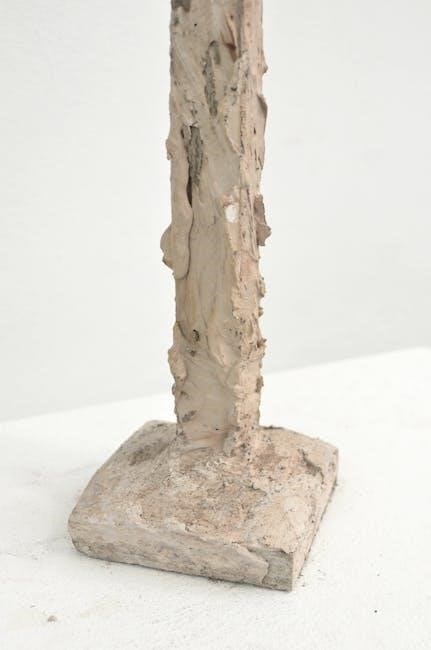The document “And of Clay We Are Created PDF” explores themes of creation, identity, and resilience through cultural and symbolic narratives, offering profound insights into human existence.
1.1 Overview of the Document
The document “And of Clay We Are Created PDF” delves into the symbolic and cultural significance of clay as a metaphor for human creation and existence. It explores themes of resilience, vulnerability, and transformation, drawing from mythological and real-world narratives. The PDF examines how clay, as a raw material, mirrors human experiences of being shaped and reshaped by external forces. Through a blend of storytelling and philosophical reflections, the document offers insights into the universal human condition, making it a thought-provoking read for those interested in identity, creativity, and the complexities of life.
1.2 Importance of the Topic
The topic “And of Clay We Are Created PDF” holds significant cultural and philosophical importance, as it explores the universal metaphor of clay in creation myths. This document sheds light on how clay symbolizes human vulnerability, resilience, and transformation, resonating across diverse cultures and belief systems. By examining the symbolism of clay, the document offers insights into identity, creativity, and the human condition, making it a valuable resource for understanding our collective and individual experiences. Its relevance spans philosophy, anthropology, and psychology, providing a deeper appreciation of existential themes.
1.3 Purpose of the Article

The purpose of this article is to decipher the profound symbolism and themes embedded in the document “And of Clay We Are Created PDF.” By examining the cultural, philosophical, and psychological dimensions of creation myths, the article aims to illuminate how clay serves as a metaphor for human existence. It seeks to provide readers with a deeper understanding of identity, resilience, and transformation, while encouraging reflection on the universal truths these narratives convey. This analysis not only explores the document’s content but also highlights its relevance in fostering personal and collective growth.
Background and Context
The PDF delves into creation myths and cultural symbolism, tracing the historical roots of clay as a metaphor for human creation and transformation across traditions.
2.1 Historical and Cultural Significance of the Phrase
The phrase “And of Clay We Are Created” draws from ancient creation myths, where clay symbolizes the raw material of human existence. Rooted in Mesopotamian and Judeo-Christian traditions, it reflects themes of divine craftsmanship and the fragility of life. Historically, clay has been a metaphor for human creation, as seen in stories like Enkidu’s formation in the Epic of Gilgamesh or Adam’s creation in Genesis. Culturally, it underscores the connection between earth and humanity, emphasizing resilience and the divine spark within mortal beings. This symbolism remains a powerful narrative across traditions and time.

2.2 Relevance of the Document in Modern Times
The themes of creation, identity, and resilience explored in “And of Clay We Are Created PDF” remain deeply relevant in modern times. In an era of digital overload, the document’s insights into human formation and purpose resonate with contemporary discussions on self-discovery and existential meaning. Its focus on symbolic narratives aligns with modern storytelling and the search for authenticity. Additionally, the document’s emphasis on clarity and precision in communication mirrors the importance of clear search queries and effective information retrieval in today’s digital landscape, making it a valuable resource for understanding both human and technological processes.
2.3 Key Themes and Messages
The document delves into themes of creation, human nature, and resilience, emphasizing the symbolic use of clay as a metaphor for human formation. It explores the connection between cultural narratives and personal identity, highlighting the importance of understanding one’s origins. The text also underscores the significance of clear communication and the precision of language in conveying complex ideas. By examining these themes, the document offers insights into the human condition, encouraging readers to reflect on their own creation and purpose, while aligning with the broader discussions on search queries and information retrieval.

Analysis of the PDF Document
The document provides a structured examination of themes, supported by detailed arguments and evidence, offering insightful analysis into its core ideas and symbolic representations.
3.1 Structure and Content Breakdown
The PDF is organized into clear sections, beginning with an introduction to its themes, followed by historical context, and detailed analysis. Each chapter builds logically, examining creation myths, cultural symbolism, and the significance of clay as a metaphor. The document includes examples and evidence to support its arguments, creating a cohesive narrative that explores human identity and resilience through symbolic storytelling.
3.2 Key Arguments and Ideas Presented
The PDF delves into the symbolic use of clay in creation myths, emphasizing its representation of human vulnerability and potential. It argues that clay, as a malleable material, mirrors the human condition—shaped by external forces yet capable of resilience. The document explores how creation stories across cultures use clay to symbolize life’s fragility and the divine-human connection. It also examines the metaphorical journey of clay, from raw earth to shaped form, reflecting human transformation and the quest for meaning in existence.
3.3 Use of Evidence and Examples
The document “And of Clay We Are Created PDF” effectively employs evidence and examples to illustrate its themes. It references creation myths from various cultures, such as Mesopotamian and Judeo-Christian narratives, where clay is central to human creation. Historical and cultural examples, including art and literature, further enrich the analysis. These examples demonstrate how clay symbolizes human vulnerability and resilience, providing depth and context to the discussion. The use of diverse evidence strengthens the document’s exploration of clay’s symbolic significance and its universal relevance across different contexts.

The Concept of Creation in the Document
The document explores creation myths and cultural symbolism, emphasizing clay as a metaphor for human origins and resilience, reflecting themes of formation and divine craftsmanship.
4.1 Symbolism of Clay in Creation Myths
Clay serves as a universal symbol in creation myths, representing malleability and impermanence. In many cultures, clay is depicted as the raw material from which life is shaped, emphasizing human vulnerability and resilience. The document highlights how clay’s transformative potential reflects divine craftsmanship and the essence of human existence. This symbolism underscores themes of creation, imperfection, and the enduring connection between the creator and the created, resonating deeply in cultural and spiritual narratives. The title itself, “And of Clay We Are Created,” embodies this profound metaphorical exploration.
4.2 The Process of Creation as Described
The document vividly portrays the creation process as deliberate and meaningful, emphasizing the transformation of clay into life. This process symbolizes divine intent and human potential, highlighting the journey from raw material to purposeful existence. It reflects the idea that creation is not random but shaped with care, mirroring the artistic process. The narrative underscores the connection between creator and creation, suggesting a deeper spiritual and existential bond. This process is not just physical but also symbolic, representing growth, purpose, and the essence of being human.
4.3 Implications of the Title “And of Clay We Are Created”
The title “And of Clay We Are Created” carries profound implications, symbolizing human vulnerability and resilience. It suggests that humans, like clay, are shaped by external forces, emphasizing the fragility and malleability of existence. The phrase also evokes themes of creation, divine or otherwise, highlighting the connection between creator and created. This duality underscores the balance between structure and chaos, purpose and randomness. Ultimately, the title invites reflection on identity, the creative process, and the universal human experience of being shaped by forces beyond our control.
Search Query Strategies for the Document
This section outlines effective search query strategies, emphasizing clarity, specificity, and the use of Boolean operators to optimize results and align with user intent.
5.1 Understanding User Intent for the Document
Understanding user intent is crucial for crafting effective search queries related to “And of Clay We Are Created PDF.” User intent refers to what the user aims to achieve, such as finding specific information, analyzing themes, or exploring cultural symbolism. By aligning search strategies with this intent, users can uncover relevant content efficiently. For this document, common intents might include exploring creation myths, analyzing literary themes, or researching cultural symbolism. Tailoring queries to these intents ensures more precise and meaningful results, enhancing the overall search experience and deeper engagement with the document’s insights.
5.2 Effective Use of Keywords and Phrases
Using specific keywords and phrases is essential for retrieving accurate results when searching for “And of Clay We Are Created PDF.” Incorporating terms like “creation myths,” “cultural symbolism,” or “human resilience” can refine searches. Combining these with Boolean operators (e.g., AND, OR) helps narrow results. For instance, searching for “creation myths AND clay symbolism” yields focused outcomes. Additionally, using quotes for exact phrases, such as “And of Clay We Are Created,” ensures relevance. This strategic approach enhances search efficiency and delivers content aligned with the document’s themes and insights.
5.3 Advanced Search Operators for Relevant Results
Advanced search operators like site:, filetype:, and inurl: can significantly enhance search accuracy. Using site: restricts results to specific websites, while filetype: targets PDFs directly. For example, searching “And of Clay We Are Created filetype:pdf” yields precise document matches. The inurl: operator helps find pages with specific URLs. Combining these with Boolean logic ensures tailored results, improving efficiency and relevance. These tools are invaluable for locating niche or specific content, making advanced operators indispensable for refined searching.

The Role of User Intent in Search Queries
User intent determines the purpose behind a search, guiding engines to deliver relevant results. It shapes how content is ranked, ensuring queries match user goals effectively.
6.1 Informational vs. Transactional Queries

Informational queries seek knowledge, such as understanding themes in “And of Clay We Are Created PDF,” while transactional queries aim to perform actions, like downloading the PDF; They differ in purpose: informational focuses on learning, while transactional targets immediate outcomes. For example, searching for “themes in And of Clay We Are Created” is informational, whereas “download And of Clay We Are Created PDF” is transactional. Understanding this distinction helps optimize search strategies and ensures users find exactly what they need, enhancing their overall search experience and satisfaction.
6.2 How User Intent Shapes Search Results
User intent significantly influences search results by guiding the relevance and type of content displayed. For “And of Clay We Are Created PDF,” informational queries yield analytical articles, while transactional intents prioritize download links. Search engines analyze keywords and context to determine if users seek knowledge or immediate actions, tailoring results accordingly. This ensures users find what they need efficiently, enhancing their search experience and satisfaction.
6.3 Optimizing for Specific User Needs
Optimizing for specific user needs involves understanding their intent and tailoring content to match. For “And of Clay We Are Created PDF,” users seeking symbolic interpretations should find in-depth analyses, while those looking for downloads need direct links. By using specific keywords like “symbolism of clay” or “creation myths,” search engines can better align results with user goals, ensuring a more relevant and efficient search experience. This approach enhances satisfaction by addressing diverse needs effectively.
Boolean Operators in Search Queries
Boolean operators like AND, OR, and NOT refine search results. Using “AND” ensures both terms appear, while “OR” broadens searches. This enhances precision when seeking specific PDF content.
7.1 Use of AND, OR, and NOT in Searches
Boolean operators like AND, OR, and NOT are essential for refining search queries. Using “AND” ensures both search terms appear in results, narrowing focus. “OR” broadens searches by including either term. “NOT” excludes irrelevant terms, enhancing precision. For example, searching “And of Clay We Are Created PDF AND symbolism” yields results focusing on symbolic themes, while “creation myths OR cultural narratives” broadens the scope. Combining these operators helps users efficiently find specific content, making Boolean logic a powerful tool for targeted searches.
7.2 Narrowing Down Results with Advanced Syntax
Advanced search syntax helps refine results by specifying exact phrases or excluding irrelevant terms. Using quotes, such as searching for “And of Clay We Are Created,” ensures exact matches. Site-specific searches, like “site:example.com creation myths,” limit results to a domain. Combining these with Boolean operators further narrows outcomes. For instance, “creation myths” AND “cultural narratives” NOT “religious” targets specific thematic discussions. These techniques enable users to locate precise, relevant information efficiently, enhancing research accuracy and productivity.
7.3 Examples of Effective Boolean Searches
Boolean searches refine results using operators like AND, OR, and NOT. For “And of Clay We Are Created PDF,” try:
“And of Clay We Are Created” AND PDF to find exact matches.
Another example: creation myths AND “clay” NOT religious to focus on cultural narratives.
These strategies help locate specific documents or related content efficiently, enhancing research precision.
The Importance of Clear and Specific Queries
Clear and specific queries enhance search accuracy, ensuring relevant results. Ambiguity can lead to irrelevant information, wasting time and effort. Precision in phrasing improves efficiency.
8.1 Avoiding Ambiguity in Search Terms
Avoiding ambiguity ensures search terms yield precise results. Vague words like “clay” may retrieve irrelevant data, such as pottery or geology. Use specific phrases like “And of Clay We Are Created PDF” or “creation symbolism in clay” to target relevant content. This clarity minimizes unrelated outcomes and focuses on the document’s themes, such as cultural narratives or symbolic meanings. Employing Boolean operators like AND or OR can further refine searches, ensuring accuracy and efficiency in retrieving desired information.
8.2 The Impact of Query Clarity on Results
The clarity of a search query significantly impacts the relevance and accuracy of results. Ambiguous terms, such as “clay,” may yield broad, unrelated information, making it difficult to find specific content. However, specific queries like “And of Clay We Are Created PDF” or “creation symbolism in clay” refine results to match the intended topic precisely. This precision is crucial for retrieving detailed insights into cultural narratives and symbolic meanings within the document. Clear queries enhance efficiency, ensuring users find exactly what they’re seeking without sifting through irrelevant data, thereby improving their overall research experience.
8.3 Best Practices for Constructing Queries
To effectively locate the “And of Clay We Are Created PDF,” employ specific search strategies. Use precise keywords like “And of Clay We Are Created PDF” or “creation symbolism in clay” to narrow results. Avoid vague terms that may yield unrelated content. Utilize Boolean operators such as AND or OR to combine concepts, ensuring relevance. Additionally, enclose phrases in quotes for exact matches, and leverage advanced search features like site-specific searches or file type filters. These practices enhance search efficiency, ensuring quick access to the desired document and its insights into cultural and symbolic themes.

Evaluating Search Results for Relevance
Evaluating search results involves assessing credibility, accuracy, and bias to ensure findings align with the topic. Verify sources and cross-check information for reliability and relevance to the PDF’s themes.
9.1 Assessing the Authority of Sources
Assessing the authority of sources involves evaluating the credibility and expertise of authors or publishers. Peer-reviewed journals, academic institutions, and reputable publishers are considered trustworthy. Check for publication dates to ensure information is up-to-date. Look for references or citations to verify the reliability of claims. For “And of Clay We Are Created PDF,” prioritize sources from established academic or cultural platforms. Be cautious of biased or unverifiable content. Cross-referencing information across multiple sources helps ensure accuracy and validity, especially for symbolic or interpretive works.

9.2 Identifying Bias or Misinformation
Identifying bias or misinformation requires critical evaluation of sources. Look for emotional language, one-sided arguments, or unverified claims. Check if the author has a vested interest or agenda. For “And of Clay We Are Created PDF,” verify interpretations against credible cultural or academic sources. Cross-reference multiple sources to ensure consistency. Be cautious of sources with unclear origins or lacking citations. Use fact-checking websites to validate controversial claims. Recognize that symbolic texts may carry inherent bias, as interpretations can vary. Always approach unfamiliar sources with skepticism and prioritize peer-reviewed or expert-endorsed materials for accuracy.
9.3 Verifying Information Across Multiple Sources
Verifying information across multiple sources ensures accuracy and reliability. For “And of Clay We Are Created PDF,” cross-reference cultural texts, scholarly articles, and reputable websites. Check publication dates to ensure recency and relevance. Look for consensus among experts to confirm interpretations. Be cautious of contradictory information and consult primary sources when possible. Use academic databases for peer-reviewed insights and verify citations. This thorough approach minimizes the risk of misinformation and ensures a well-rounded understanding of the document’s themes and symbolism.
The “And of Clay We Are Created PDF” offers profound insights into creation symbolism, human resilience, and cultural identity, inspiring reflection on our shared human experiences.
10.1 Summary of Key Points
The discussion highlights the importance of user intent in shaping search queries and results. The “And of Clay We Are Created PDF” explores creation myths, identity, and resilience, emphasizing cultural significance and modern relevance. The document underscores the value of clear and specific queries in retrieving accurate information, while its title symbolizes human vulnerability and strength. By examining search strategies and cultural themes, the text provides insights into effective information retrieval and the enduring relevance of creation narratives in understanding human existence.
10.2 Practical Applications of the Document’s Insights
The insights from “And of Clay We Are Created PDF” can be applied to enhance search query strategies, emphasizing clarity and specificity. Educators can use the document’s themes to teach critical thinking and cultural awareness. Researchers can apply its symbolic narratives to explore identity and resilience in various contexts. Additionally, the document’s focus on creation myths offers a framework for understanding human experiences, making it a valuable resource for interdisciplinary studies and personal reflection, ultimately enriching both academic and everyday problem-solving processes.
10.3 Encouragement for Further Exploration
Exploring “And of Clay We Are Created PDF” offers a rich journey into cultural narratives and existential themes. Readers are encouraged to delve deeper into its symbolic meanings and apply these insights to personal growth and academic research. The document’s universal themes make it a valuable resource for fostering discussions on identity, resilience, and creation myths. Embrace the opportunity to engage with its profound messages and continue uncovering the layers of wisdom it presents, inspiring a deeper understanding of human experiences and cultural heritage.
